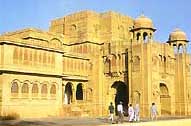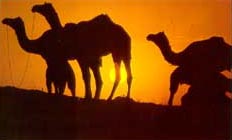| Destinations
|
|||||||||||||||
Before Independence in 1947, Rajputana, as it was called, comprised of 18 princely states, two chiefships, the small British-administered province of Ajmer-Merwara, and a few pockets of territory outside the main boundaries. After 1947 the princely states and chiefships were integrated into India in several stages, and the state took the name of Rajasthan, assuming its present form on Nov.1, 1956. Rajasthan in northwestern India, with an area of 342,239 square kilometers, is bounded on the west and northwest by Pakistan, on the north and northeast by the states of Punjab, Haryana, and Uttar Pradesh, on the east and southeast by the states of Uttar Pradesh and Madhya Pradesh, and on the southwest by the state of Gujarat. |
More on Rajasthan • History • Geography • People & Culture • Economy • Festivals • Wild Life • Adventure • Climate Cities • Ajmer Shareif • Alwar • Bharatpur • Bikaner • Chittaurgarh • Jaipur • Jaisalmer • Jodhpur • Kota • Mount Abu • Ranakpur • Sariska • Udaipur
Travelogues
Impressions | ||||||||||||||
The Tropic of Cancer passes
through Banswara district in the extreme south of Rajasthan.
The state is diagonally divided into the hilly and rugged south eastern
region and the barren north western Thar desert which extends across the
border into Pakistan.
The capital city, Jaipur, familiarly known as the Pink City, is the stronghold of a clan of rulers in the past. Three hill forts and a series of palaces are the major attractions here. Western Rajasthan itself forms a convenient tourism circuit in the heart of the Thar desert. The three cities of Jodhpur, Jaisalmer and Bikaner create a perfect portrait of this beautiful desert land. Jodhpur, on the edge of the desert was once the capital of the state of Marwar. Dominating the city is the hilltop fort of Mehrangarh with a magnificent view of the Umaid Bhawan Palace, built of golden sandstone in the early part of this century.
Bikaner is also an impressive testimony to the past, with its amazing sandstone palace, temples and cenotaphs. In the north of Rajasthan is the Shekhavati region easily approachable from Jaipur by road. The greatest attractions here are the deserted mansions of local merchants, decorated with wall paintings of various subjects and styles. Nearby are Dundlod and Mandawa, rugged forts which are now converted into hotels, surrounded by an aura of rare medieval charm. People and Culture
In Udaipur, the erstwhile royal house of Mewar has palaces, lakes, temples and cenotaphs. Chittaurgah, Kumbalgarh and Mandalgarh, near Udaipur, are famous for their almost impregnable forts. Situated on an isolated plateau, about 1200 meters above sea level, Mount Abu, famous for its exquisitely carved Jain temples, is a delightful hill resort that has the added attraction of being equally attractive in the summer and winter. The main attractions here are the Dilwara Jain temples, of which the Adinath and Neminath, display an incredible wealth of carving in white marble.
Rajasthan is known for its handicrafts and paintings. It is associated with a rich tradition of art, culture, music and dance. Rajasthan with it's flamboyant dresses, steeped in the history of a princely state with love of opulence and the arts gave rise to some of the most splendid examples of jewellery in the world. An exotic land of colourful festivals, Rajasthan has a varied and unique festival calendar that attract visitors from all corners of the globe. Well connected with other parts of the country, it can easily be accessed from Delhi and Mumbai. Convenient flights, fast trains and direct buses make travel easy and comfortable.
|
|||||||||||||||
Editor: Romola Butalia (c) India Travelogue. All rights reserved. |
|||||||||||||||
 Battle scarred forts, turreted marble palaces of breathtaking grandeur and
whimsical charm, delightful folk art and culture, riotous colours and a
romantic sense of pride and honour. When the sun sets, the desert sands
are set aflame, reflected in the camel rider's multi-hued headgear. The
Rajasthani woman who belongs to this desert, fashions her many coloured
garment in imitation of nature's primordial colour scheme. A land of
contrasts. Lakes in the midst of desert sands. An aura of history that
lives. Temples that date back to the 7th century that are still the
hallowed ground of worship. Elephants and camels on winding tarred roads.
Majestic modern hotels in palaces of old. Tales that never end. Mystery
and romance. An unforgettable past, an unbelievable dream.
Battle scarred forts, turreted marble palaces of breathtaking grandeur and
whimsical charm, delightful folk art and culture, riotous colours and a
romantic sense of pride and honour. When the sun sets, the desert sands
are set aflame, reflected in the camel rider's multi-hued headgear. The
Rajasthani woman who belongs to this desert, fashions her many coloured
garment in imitation of nature's primordial colour scheme. A land of
contrasts. Lakes in the midst of desert sands. An aura of history that
lives. Temples that date back to the 7th century that are still the
hallowed ground of worship. Elephants and camels on winding tarred roads.
Majestic modern hotels in palaces of old. Tales that never end. Mystery
and romance. An unforgettable past, an unbelievable dream.
 In the south west of Rajasthan are Bundi, Kota and Jhalawar famous for
their palace-forts, galleries of fine frescoes and stunning temples. For
lovers of wildlife, Kota also has the Dara wildlife sanctuary where
tigers, bears, wild boars and spotted deer roam the thick green jungles.
About 135 kilometres southwest of Jaipur is Ajmer, a sacred Muslim
pilgrimage destination. 14 kilometres from Ajmer is Pushkar, where
thousands of pilgrims gather to bathe in the sacred lake on the full moon
in November, when Pushkar hosts one of the largest cattle fairs in
Rajasthan.
In the south west of Rajasthan are Bundi, Kota and Jhalawar famous for
their palace-forts, galleries of fine frescoes and stunning temples. For
lovers of wildlife, Kota also has the Dara wildlife sanctuary where
tigers, bears, wild boars and spotted deer roam the thick green jungles.
About 135 kilometres southwest of Jaipur is Ajmer, a sacred Muslim
pilgrimage destination. 14 kilometres from Ajmer is Pushkar, where
thousands of pilgrims gather to bathe in the sacred lake on the full moon
in November, when Pushkar hosts one of the largest cattle fairs in
Rajasthan.